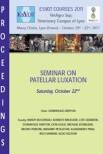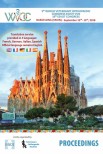Reasons for performing the study: Hoof health is a major concern of horse owners as well as the equine industry. However, many questions remain concerning regional variations of laminar junction and its potential to remodel.
Hypothesis: To examine regional variations in the morphology of the laminar junction and thickness of the hoof wall in Thoroughbred horses.
Methods: The forefeet of 25 Thoroughbred cadavers were examined. Each hoof was divided into 20 blocks through 4 proximodistal slices (below the coronary band, each 1 cm apart) and 5 circumferential positions (toe, medial and lateral quarters and heels). In each block, 25 central primary epidermal laminae (PEL) were considered. Orientation of each lamina in relation to the hoof wall (LO), degree of bending (IA) and the spaces between the adjacent laminae (LS) were measured. Thickness of the hoof wall and number of branched PEL were also measured. Data were analysed using a split-block design in ANOVA.
Results: There were significant differences between the 2 proximal and 2 distal slices in LO and IA data, but not in LS data. Circumferentially, toe blocks were different from heel and quarters blocks. Lateral and medial heels as well as the quarters were mostly different. The hoof wall was slightly thicker laterally than medially. There were more branched PEL on the lateral side of the left hooves and on the medial side of the right hooves.
Conclusions: These data add to the circumstantial evidence supporting the hypothesis of adaptive remodelling in the laminar junction. Results of this study signify the capability of PEL to remodel in response to applied stress to the regions of the hoof.
Potential relevance: A deeper understanding of the gross and cellular processes of laminar remodelling may well prove to be complementary to an understanding of their failure in laminitis.









